
The Round House (Dutch: Ronde Huis) was a round villa in the Netherlands, located in the municipality of Nunspeet. [1] It was demolished in 1967 but its traces remain visible in the landscape.

The Round House (Dutch: Ronde Huis) was a round villa in the Netherlands, located in the municipality of Nunspeet. [1] It was demolished in 1967 but its traces remain visible in the landscape.
In 1890 Frank van Vloten (1858–1930), from the Dutch patrician family Van Vloten, purchased the estate Groeneveld in Hulshorst, in the municipality of Nunspeet. He sold the property in 1891 to his wife Constance Lans and they finally moved into the property in 1893. In 1895 Frank van Vloten purchased land closer to the village of Nunspeet and together with his brother Willem van Vloten he founded the company Nieuw Nunspeet. In 1902 another 360-hectare patch of land was added to the company. In 1906 the first stone was laid of a round villa which would become known as Het Ronde Huis (The Round House).
The Round House had three floors and a flat roof. An entrance road circled around the house towards the main entrance on the second floor which had a balcony all around the house. The round inner gallery on the third floor received daylight through a couloured glass dome in the roof. After the establishment of the Round House the surroundings were transformed to a landscape park.
The estate included roughly the area between Nunspeet railway station and Vierhouten, with remains of the park still visible in the form of ponds surrounded with Rhododendron bushes and a Honey locust. Van vloten experimented with different forestry management methods and introduced several alien tree species and plants. Nowadays, the Nunspeet golf course is situated on part of the former estate.
Frank van vloten constructed a 600 mm (1 ft 11 5⁄8 in) pony-drawn tramway from his estate to Nunspeet railway station. It was built in Decauville-style portable rail track. One surviving tram carriage was restored to working order at the Pony- en Motortram 't Joppe and now resides at the Stichting Rijssens Leemspoor heritage railway.
Frank van Vloten died in 1930. The estate was divided and sold. The house and its surroundings became now property of Staatsbosbeheer and started deteriorating, other parts of the estate were clearcut by a local forester.
During the Second World War the house was used as a labour camp of the Dutch Arbeitseinsatz. Nearby refugees hid in the forest in a shelter later to become known as the Verscholen Dorp (Hidden village). In 1944 a Rheinbote ballistic missile launchpad was constructed on the estate.
After the war the former labour camp became a family resort for social weak families and from 1961 to 1966 it was a holiday camp. At the end of the sixties it was decided to demolish the house and camp.
Articles published in 1976 and 2006 speculated that Frank van Vloten organised orgies and occult rituals at the Round House. In 2011 a Dutch weblog published an even more extreme version of these rumours and the subject was debated on the Dutch FOK! forum, where several participants started an investigation. In 2012 a controversial book was published which stated that Frank van Vloten was a member of a Pan-Germanist cult [2] and the publication attracted some media coverage. Two magazines, Skepter and G-Geschiedenis, put the theory in question in 2013, [3] followed by two crime thrillers in 2014, loosely based on the rumours. A new non-fiction book was published on June 14, 2014 in which the conspiracy theories are dubbed a saga. There are absolutely no grounds to suspect Frank van Vloten as a pan-German occultist and a lot of written statements have proven that nothing out of the ordinary happened in the extraordinary house. [4]

Holland is a region and former province on the western coast of the Netherlands. The name Holland is also frequently used informally to refer to the whole of the country of the Netherlands. This usage is commonly accepted in other countries, and sometimes employed by the Dutch themselves. However, some in the Netherlands, particularly those from regions outside Holland, may find it undesirable or misrepresentative to use the term for the whole country.

Ermelo is a municipality and town in the Netherlands; found within Gelderland province and the forest-rich Veluwe area. The 2019 population was 26,858.

Lochem is a municipality and city in the Eastern Netherlands. On 1 January 2005, it merged with the municipality of Gorssel, retaining the name of Lochem.

Nunspeet is a municipality and town in the central Netherlands. It has been an agricultural site since prehistoric times. The municipality contains a number of villages, namely Hulshorst, Elspeet, and Vierhouten. Nunspeet has a vivid historical foundation, called Nuwenspete. In 1973 Nunspeet became a separate municipality after having been part of Ermelo before.

Zeist is a municipality and a town in the central Netherlands, located east of the city of Utrecht.
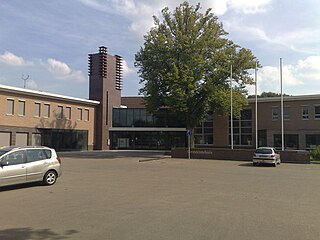
Eersel is a municipality and a town in southern Netherlands in the province of North Brabant. Eersel is situated in the Campine (Kempen) area.

Het Loo Palace is a palace in Apeldoorn, Netherlands, built by the House of Orange-Nassau.
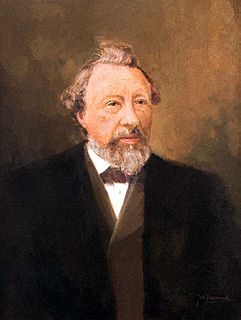
Johan Hendrik Caspar Kern was a Dutch linguist and Orientalist. In the literature, he is usually referred to as H. Kern or Hendrik Kern; a few other scholars bear the same surname.
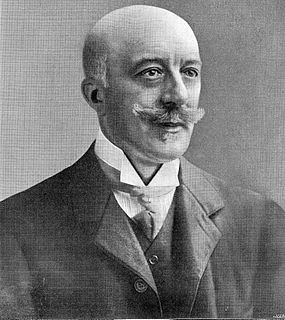
Cyrillus Gustave Emile "Cyriel" Buysse was a Flemish naturalist author and playwright. He also wrote under the following pseudonyms: Louis Bonheyden, Prosper Van Hove and Robert Palmer.
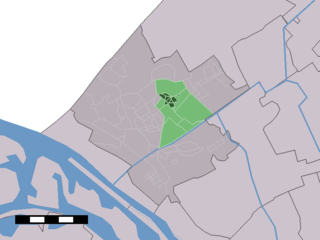
Honselersdijk is a town in the Dutch province of South Holland. It is home to the historic Huis Honselaarsdijk, former palatial estate of the Dutch Princes of Orange. Huis Honselaarsdijk was one of the finest examples of Baroque architecture and grounds in the history of The Netherlands. Today, only part of the outbuildings remain, and these are referred to locally as "De Nederhof".

The Yellow House, alternatively named The Street, is an 1888 oil painting by the 19th-century Dutch Post-Impressionist painter Vincent van Gogh.

The Anne Frank House is a writer's house and biographical museum dedicated to Jewish wartime diarist Anne Frank. The building is located on a canal called the Prinsengracht, close to the Westerkerk, in central Amsterdam in the Netherlands.
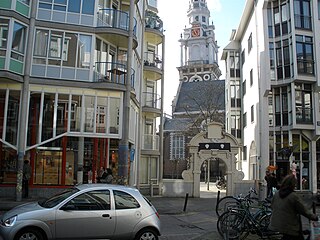
The Sint Antoniesbreestraat is a street in the centre of Amsterdam in the Netherlands. The street runs south from Nieuwmarkt square to the Sint Antoniesluis sluice gates, where it continues as the Jodenbreestraat. The Sint Antoniesbreestraat is primarily a shopping street with a variety of specialty shops. At the corner of Sint Antoniesbreestraat and Hoogstraat is an entry to the Nieuwmarkt stop of the Amsterdam Metro system.
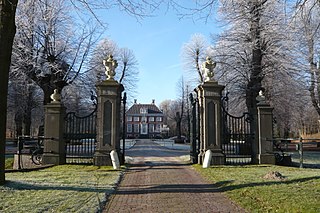
The Huis te Manpad is an historical villa and former summer home of Jacob van Lennep in Heemstede, the Netherlands; bordered by the Leidsevaart canal, the Manpadslaan, and the Herenweg. It neighbors the estate of Hartekamp, famed for the gardens described by Carl Linnaeus. Both estates still have trees and other flora dating from that period.

The Hollandsche Manege in Amsterdam is the oldest riding school in the Netherlands, dating back to 1744. The current building, inspired by the Spanish Riding School in Vienna, was constructed in 1882. The building has been declared a rijksmonument.

Amsterdamsche Football Club, known as AFC is a football club from Amsterdam, Netherlands. It is currently playing in the Tweede Divisie, the third tier of football in the Netherlands.

The Koninklijke Hollandsche Maatschappij der Wetenschappen, located on the east side of the Spaarne in downtown Haarlem, Netherlands, was established in 1752 and is the oldest society for the sciences in the country. The society has been housed in its present location, called Hodshon Huis, since 1841. Nearby the society is the Teylers Museum, a closely related museum of natural history founded in 1784. In 2002 the society was awarded the predicate "Royal" when it celebrated 250 years of science studies.

The Korenbeurs was a 17th-century commodity market in Amsterdam where grain was traded. The building stood on the banks of the Amstel, on the western (Nieuwezijde) side of the Damrak. It was directly south of the Oude Brug bridge, on a spot now occupied by the former stock and commodity exchange Beurs van Berlage.

Winschoten is an unstaffed railway station in Winschoten in the Netherlands. It is located on the Harlingen–Nieuweschans railway between Scheemda and Bad Nieuweschans in the province of Groningen.

The Tabakspanden are a group of buildings standing on the Spuistraat in central Amsterdam, adjacent to the Keizerrijk and Wijdesteeg alleyways. Named after a previous owner called Hendrik Tabak, they were mostly squatted from 1983 onwards, although Peter Klashorst also rented an apartment and gallery space. Two of the buildings are registered as rijksmonumenten.